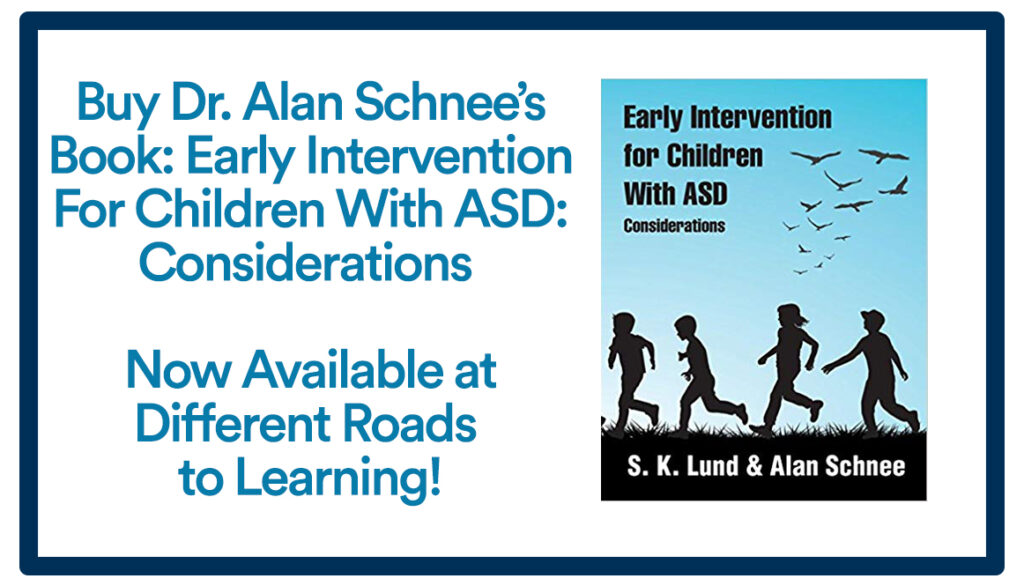By Alan Schnee, Ph.D, BCBA-D.

Roughly 34% of the 50 most common words used in English are pronouns. Yet, with few exceptions, children on the spectrum struggle to use them.
Why is it so difficult for children to learn? One likely reason is that the use of pronouns is contextually determined. Learning to use them requires vigilant tracking across shifting speakers and listeners (you, I, they, he, she, Ralph, etc.), and shifting events. It is a complex process requiring acute attention to who is in possession of what, changes in possession, attention to who did or said what, and who did or said what to whom, etc. If our goal is to assist in teaching children to use and respond appropriately to pronouns, where should we begin?
First, we need to clear up some confusion Pronouns are words that stand in for nouns. Though it is commonly said that we ‘tact pronouns’, saying this lacks sense. Pronouns are not objects or events or properties of an object or event. They are simply words. They exist in language and are used within a normative linguistic practice. There are no pronouns in the world and thus it makes no sense to say we “tact” them.
When it comes to learning pronouns, children need to learn the complicated things we do when we use them; under which circumstances we use which one(s) and the ‘linguistic acrobatics’ required for fluent use. So, for example, when a child is told to, “Go tell Mommy that you need her keys, they need to be able to formulate the response, “Mommy, I want your keys.”
Teaching pronouns needs to be taken slowly and requires considerable practice (repetition). It requires getting rudiments in place before tackling more complex arrangements and objectives.
Early pronoun exercises quickly become far more complex as ‘transformations’ are required. For example, a standard “My/Your program”, (teacher says, “Touch my nose or touch your nose”) requires learning a straightforward discrimination. However, once a follow-up question such as “Whose nose is this?”, is presented, things become very difficult for children since they need to switch their response such that what was just “my” becomes “your” and visa versa. Instruction in the use of pronouns requires meticulous execution of discrete trials. Additionally, echoic prompting is contra-indicated. Children will need to learn to respond to a “say” instruction. The exercise below, taken from Lund and Schnee (2018) illustrates just how complicated teaching use of pronouns can be.
Nominal Pronouns (4): Shifting speakers
(This sample exercise follows more basic ‘pronoun’ exercises.)
Purpose
To teach the child to use nominative pronouns “I” and “You”, combined with proper names
Set Up
Three or more persons required
Have the child hold an object (e.g. cup) and you and an assistant each hold different objects. You and the assistant rotate asking.
Procedure
Step one: You and assistant rotate asking, “Who has the “X” (e.g. cup) vs “Who has “Y” (e.g. ball), “Who has “Z” (e.g. spoon). When you ask questions regarding the assistant, the child refers to her by name. When you are the spectator and the assistant is asking questions ,the child will refer to you by your proper name and the assistant as “you”. Of course the child always refers to themselves as “I” and when you are asking, the child refers to “you” as “you”.
Step two: You or assistant ask the child “What do you have” , “What do I have”, “What does (person/proper name have?)”.
Prompt correct responses according to who is in possession of each object, i.e, I have the X or You have Y, ‘Proper name’ (Sally) has Z . This is more difficult than step one because if requires transforming the pronoun. Make sure to change what each of you is holding so that the child will not memorize responses.
Considerations
This exercise is not only matter of answering questions. It entails personal deixis; the right answer depends on who is asking. The primary goal is to teach the child to say “you” when the speaker asks the child what the speaker is holding, to say “I” when the speakers asks about what the child is holding and to use a proper name when the child is asked about what any other person is holding (if that person is not the speaker). This discrimination requires considerable practice.
If the child struggles with these arrangements, segment instruction into smaller ‘switched’ sequences as described in step 3 of Assigning Pronouns to Pictures of Persons 1.
About the Author
Alan Schnee, Ph.D, BCBA-D. offers consultations to families, schools, and other organizations wishing to enhance their programs so that their children derive maximum benefit from services. His unique approach increases learning efficiencies, broadens the scope, depth, and breadth of your program, provides clarity for children and teachers and imparts sensible purpose and directions to teams and parents.

